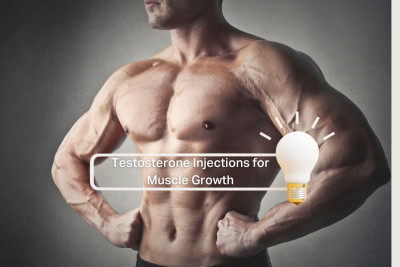How Long Do Testosterone Injections Take To Work? A Complete Timeline Of Effects


Testosterone replacement therapy (TRT) is a widely used treatment for individuals experiencing low testosterone levels, helping to improve energy, mood, muscle mass, and overall well-being.

In Canada, TRT is becoming an increasingly common option for those seeking to restore hormonal balance and enhance their quality of life. However, one of the most common questions among individuals starting testosterone replacement therapy (TRT) in Canada is: How long does it take for testosterone injections to work?
Understanding the timeline for different therapeutic effects is essential for setting realistic expectations and tracking progress. While some benefits appear within weeks, others take several months to fully develop. This article provides a clear breakdown of when to expect noticeable changes in various aspects of health after starting testosterone injections.
Topics covered in this article:
How Testosterone Injections Work in the Body
Testosterone injections deliver synthetic testosterone directly into the bloodstream, helping to restore hormone levels in individuals with low testosterone. Unlike natural testosterone production, which occurs in the testes, testosterone replacement therapy (TRT) in Canada relies on intramuscular or subcutaneous injections to ensure a steady release of the hormone. Once injected, testosterone is gradually absorbed into the bloodstream, where it binds to androgen receptors in tissues like muscles, bones, and the brain, influencing various physiological functions.

There are different types of testosterone esters, which affect how quickly the hormone is released and metabolized:
- Testosterone Enanthate: One of the most commonly used esters, it has a moderate release rate, typically requiring injections every 5 to 10 days.
- Testosterone Cypionate: Similar to enanthate but with a slightly longer half-life, requiring injections approximately every 7 to 14 days.
- Testosterone Undecanoate: A long-acting ester with an extended release period, often administered every 10 to 12 weeks under medical supervision.
The choice of testosterone ester depends on individual needs, treatment goals, and how the body responds to therapy. Some individuals prefer shorter-acting esters for more frequent, stable hormone levels, while others opt for long-acting injections for convenience. Understanding the pharmacokinetics of different esters helps in optimizing TRT for maximum effectiveness and minimal side effects.
When to Expect Results from Testosterone Injections
Testosterone injections work at different rates depending on the specific benefit being targeted. While some effects appear within weeks, others take months or even years to fully develop. Here’s a breakdown of how long it takes for testosterone replacement therapy (TRT) in Canada to produce noticeable changes:
- Sexual Function: An increase in sexual interest is often observed within three weeks, with levels stabilizing around six weeks. However, improvements in erections and ejaculations may take up to six months to reach their full effect.
- Mood and Quality of Life: Many individuals experience improvements in mood, energy levels, and overall well-being within three to four weeks. However, maximum benefits may take several months to become fully noticeable.
- Muscle Mass and Strength: Increases in lean body mass and muscle strength typically occur between 12 and 16 weeks, continuing to improve and stabilize over 6 to 12 months. Some individuals may see marginal gains beyond the first year, depending on their fitness regimen.
- Fat Mass Reduction: TRT helps reduce fat mass, with noticeable changes occurring within 12 to 16 weeks. Fat loss continues to improve until it stabilizes between 6 and 12 months.
- Bone Density: While testosterone injections benefit bone health, these effects take longer to develop. Bone density improvements become detectable after six months and can continue for at least three years.
Each individual responds differently to TRT, and factors such as dosage, lifestyle, and overall health influence the timeline of results. Regular monitoring with a healthcare provider ensures that testosterone levels remain optimal for maximizing benefits while minimizing side effects.
Factors Influencing How Quickly TRT Works
The timeline for experiencing the effects of testosterone replacement therapy (TRT) in Canada varies between individuals. Several factors influence how quickly the body responds to testosterone injections, including dosage, administration method, and personal physiology.

- Dosage and Frequency: Higher doses may lead to earlier onset of effects, particularly for symptoms like increased libido and mood enhancement. However, studies show that over time—typically within six months—the differences in effectiveness between higher and lower doses tend to level out. Proper dosing is crucial, as excessive testosterone can lead to hormonal imbalances and side effects.
- Individual Variability: Each person’s genetics, baseline hormone levels, metabolism, and overall health impact how quickly TRT takes effect. Individuals with severely low testosterone at the start of therapy may experience faster improvements, whereas those with moderate deficiencies may notice gradual changes. Factors such as age, lifestyle, and pre-existing medical conditions also contribute to response time.
- Administration Route: The way testosterone is administered affects absorption and release rates.
- Intramuscular (IM) Injections: Injected deep into the muscle, IM testosterone tends to enter the bloodstream faster, leading to more immediate effects compared to subcutaneous injections.
- Subcutaneous (SubQ) Injections: Delivered into the fatty layer beneath the skin, SubQ injections provide a slower, more stable release, reducing hormone fluctuations and potentially improving long-term tolerability.
By considering these factors, individuals on TRT can better understand their response timeline and work with healthcare providers to optimize dosage and administration methods for the best results.
Monitoring Progress and Setting Realistic Expectations
Regular monitoring is essential for individuals undergoing testosterone replacement therapy (TRT) in Canada to ensure that treatment is effective and safe. While testosterone injections offer significant benefits, their effects do not occur overnight. Setting realistic expectations and maintaining medical supervision can help optimize outcomes while minimizing potential risks.
- Importance of Regular Monitoring: TRT requires ongoing blood tests and medical evaluations to track testosterone levels, monitor hormone balance, and assess overall health. Healthcare providers typically check for:
- Testosterone and dihydrotestosterone (DHT) levels to ensure they remain within the optimal range.
- Estrogen levels, as testosterone can convert into estrogen, potentially leading to unwanted side effects.
- Red blood cell count and cardiovascular markers to prevent complications such as high hematocrit, which can increase the risk of blood clots.
Regular follow-ups also allow healthcare providers to adjust dosage and injection frequency if necessary, ensuring that patients achieve the best possible therapeutic effects with minimal side effects.

- Setting Realistic Expectations: While some effects of TRT, such as improved mood and libido, may become noticeable within a few weeks, muscle growth, fat loss, and bone density improvements take months or even years to reach their full potential. Understanding this timeline helps individuals remain patient and committed to their therapy, avoiding frustration or unrealistic expectations.
By combining consistent monitoring with a well-structured TRT plan, individuals can safely and effectively experience the full benefits of testosterone therapy while minimizing risks.
Conclusion
Testosterone replacement therapy (TRT) provides a range of benefits, but its effects develop gradually over time. While improvements in mood and libido can be noticed within a few weeks, muscle growth, fat loss, and bone density changes require months to reach their full potential. Understanding this timeline helps individuals set realistic expectations and track their progress effectively.
Each person’s response to TRT is unique, influenced by factors such as dosage, administration method, genetics, and overall health. This is why individualized treatment plans and regular medical monitoring are essential. Blood tests, dosage adjustments, and ongoing consultations with healthcare providers help optimize results while minimizing risks and side effects.
By maintaining patience, consistency, and medical supervision, individuals undergoing testosterone replacement therapy in Canada can safely experience the full benefits of hormone optimization, improving their quality of life and long-term well-being.
Frequently Asked Questions (FAQs)
Some effects, like increased libido and mood improvements, can appear within 3 to 4 weeks. Muscle growth, fat loss, and strength gains typically take 12 to 16 weeks, while bone density improvements can take 6 months or more.
Increases in lean muscle mass usually begin within 12 to 16 weeks, with continued improvements over 6 to 12 months. Strength gains may continue for several years with consistent training and proper hormone levels.
Yes, many people notice improvements in mood, motivation, and energy within 3 to 4 weeks of starting TRT, though maximum benefits may take a few months.
Regular blood tests are recommended every 3 to 6 months to ensure that testosterone, DHT, estrogen, and red blood cell levels remain balanced. This helps adjust dosages if needed.
Yes. Shorter-acting esters (like enanthate and cypionate) require weekly or biweekly injections and may lead to faster effects. Longer-acting esters (like undecanoate) provide a more gradual release, requiring fewer injections but taking longer to stabilize hormone levels.
Genetics, baseline testosterone levels, dosage, injection frequency, and overall health all play a role in how soon the effects of testosterone therapy become noticeable.
Yes, reductions in fat mass are typically noticeable within 12 to 16 weeks, with more significant changes occurring over 6 to 12 months as testosterone improves metabolism and muscle growth.
The best way to optimize results is through a balanced diet, strength training, quality sleep, and stress management. Taking higher-than-prescribed doses is not recommended, as it can increase risks without necessarily improving benefits.
Yes, but it takes time. Bone density improvements usually become noticeable after 6 months, with continued gains over 3 years or more.
Regular blood tests and monitoring symptoms are essential. If you experience persistent fatigue, mood swings, or hair loss, your doctor may need to adjust your dosage or check other hormone levels.
References
UPGUYS has strict sourcing guidelines to ensure our content is accurate and current. We rely on peer-reviewed studies, academic research institutions, and medical associations. We strive to use primary sources and refrain from using tertiary references.- The benefits and risks of testosterone replacement therapy: a review, PubMed,
https://pmc.ncbi.nlm.nih.gov/articles/PMC2701485/ - Testosterone depot injection in male hypogonadism: a critical appraisal, PubMed,
https://pmc.ncbi.nlm.nih.gov/articles/PMC2686335/ - Long vs short acting testosterone treatments: A look at the risks, PubMed,
https://pmc.ncbi.nlm.nih.gov/articles/PMC9925408/ - Onset of effects of testosterone treatment and time span until maximum effects are achieved, PubMed,
https://pmc.ncbi.nlm.nih.gov/articles/PMC3188848/#:~:text=Results,but%20maximum%20benefits%20take%20longer.
This article is written for informational purposes only and does not constitute medical advice. The information provided in the articles cannot and should not replace advice from a healthcare professional. Talk to your healthcare provider about any physical or mental health concerns or the risks and benefits of any treatment or medication.





